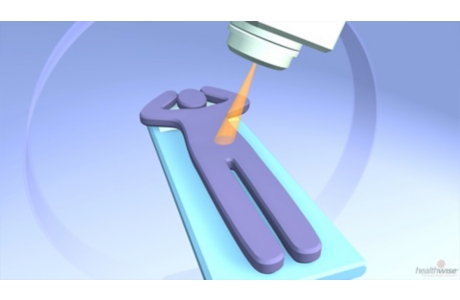Radiation Therapy for Cancer Pain
Treatment Overview
Radiation therapy is the use of X-rays to destroy cancer cells and shrink tumors. Radiation damages the cells in the area being treated, stopping or slowing the growth of the cancer cells.
Radiation is also used to control pain by destroying a growing tumor that is invading or interfering with normal tissue, such as when a tumor presses on bones, nerves, or other organs. This may be done with radiation to part of the body or, in rare cases, with radiation to the whole body. Or you may be given a shot with a radioactive medicine.
What To Expect
Radiation therapy can reduce pain by shrinking a tumor. And for cancer that has spread to the bones, walking and moving around may be less painful.footnote 1
Why It Is Done
Radiation therapy is used to control pain when a growing tumor invades or interferes with normal tissues, such as bones, nerves, or other organs.
How Well It Works
Radiation therapy can reduce pain. One or more treatments may be needed to relieve pain.
Risks
Side effects are common with radiation therapy and may depend on what area of the body receives radiation. Side effects can include:
- Fatigue.
- Nausea, vomiting, and diarrhea.
- A cough or chest pain.
- A flare-up of pain that lasts for a few days. This is common with treatment for bone tumors.
Side effects can be treated with pain medicines and anti-nausea medicines. They usually go away 4 to 6 weeks after treatments are done. Long-term side effects are uncommon.
What To Think About
While radiation therapy may not cure the cancer that is causing pain, it may reduce symptoms and slow the spread of the disease.
Credits
Current as of: December 19, 2018
Author: Healthwise Staff
Medical Review:E. Gregory Thompson, MD – Internal Medicine & Kathleen Romito, MD – Family Medicine & Jimmy Ruiz, MD – Medical Oncology, Hematology
Current as of: December 19, 2018
Author: Healthwise Staff
Medical Review:E. Gregory Thompson, MD – Internal Medicine & Kathleen Romito, MD – Family Medicine & Jimmy Ruiz, MD – Medical Oncology, Hematology
This information does not replace the advice of a doctor. Healthwise, Incorporated, disclaims any warranty or liability for your use of this information. Your use of this information means that you agree to the Terms of Use. Learn how we develop our content.



